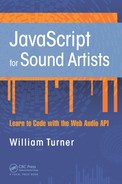Preface
Learning to program can be daunting, and we want to be the first to congratulate you for taking on the challenge! Second, we want to thank you for choosing this book.
 Who Is This Book For?
Who Is This Book For?
This book is for anyone who is involved in the world of creative audio and wants to learn to program using the JavaScript language. There are many programming books directed toward artists to help them build websites, mobile applications, games, and other things, but next to none is directed exclusively toward the sound arts community. This book is designed to fill this role and to teach the fundamentals of web-based software development, and specifically, the basics of the JavaScript programming language to sound artists.
 What This Book Is Not
What This Book Is Not
This book is not an audio technology reference. It does not take the time to explain the fundamentals of audio theory or sound engineering in depth. Words and phrases like dynamic range compression, convolution reverb, and sample rate are thrown around like candy with only a cursory explanation (if they are explained at all). We assume that you are either familiar with many of these core audio concepts or know enough to find the answers on your own. If you need an accommodating audio technology reference, we suggest David Miles Huber’s excellent book Modern Recording Techniques, Taylor & Francis.
This book is also not directed toward experienced programmers who are simply interested in JavaScript or the Web Audio API. If this describes you, then you may find some value here, but you are not the intended audience.
 How to Learn to Program
How to Learn to Program
The following are a few tips to help you get the most from this book.
Make Connections
Generally, it is easier to learn new things by making associations and connections to areas that you are already familiar with. If you have ever programmed a synth or a MIDI sequencer, then you have already done a form of programming. The contents of this book are designed to be a bridge that connects a world you are (presumably) familiar with (sound and audio technology) to a topic you are less familiar with—JavaScript and programming. We suggest that you tap into whatever has drawn you to sound art while learning the material in this book.
Flow and Frustration Are Not Opposites
It’s very important to embrace a sense of flow when learning to program. It is also important to embrace frustration as part of the flow state and not as the antithesis of it. When you learn something new, the neurons in your brain are making connections; this may physically feel like frustration, but it just means your brain is rewiring—literally. Embrace this.
Make It Habitual
Programming is all about learning a bunch of little things that combine to make big things. The best way to learn a lot of little things is through repetition and habit. One way to do this is to simply accept programming as a new part of your lifestyle and do a little bit (or a lot) every day.
Be Creative and Have Personal Projects
It is a good idea to have your own personal programming projects. The more you are personally invested in a project, the more you will learn.
Talk and Teach
One of the best ways to validate your own learning is to teach someone else. If you don’t have anyone to teach, then you can substitute this by writing tutorials. This will force you to collect your thoughts and express them clearly.
Keep Going
Our final piece of advice is to simply stick with it.
Best of luck!
If you have any questions or comments, you can find us at:
http://www.javascriptforsoundartists.com
William Turner
Steve Leonard
